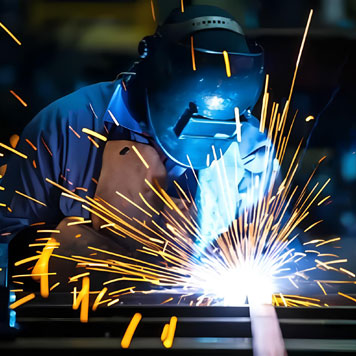Welding is the backbone of modern manufacturing, construction, and fabrication. From automotive parts to skyscrapers, strong and precise welds ensure the safety, durability, and performance of structures and machinery. But with the rise of advanced robotics and automation, many businesses face a key decision: Should they stick with manual welding or invest in automated welding systems?
This article compares both approaches, highlighting their advantages, drawbacks, and cost implications.
Manual Welding
What it is:
Manual welding involves a trained human welder controlling the welding torch, angle, speed, and positioning. Common methods include Shielded Metal Arc Welding (SMAW), Gas Metal Arc Welding (GMAW/MIG), and Gas Tungsten Arc Welding (GTAW/TIG).

✅ Pros of Manual Welding
- Flexibility: Skilled welders can adapt to different projects, materials, and positions (flat, vertical, overhead, etc.).
- Lower Initial Investment: Requires relatively inexpensive equipment compared to robotic systems.
- Versatility for Complex Jobs: Ideal for small batches, custom fabrications, or intricate designs.
- Quick Setup: Minimal setup time; suitable for on-site and repair work.
❌ Cons of Manual Welding
- Labor-Intensive: Quality depends heavily on the welder’s skill and consistency.
- Slower Production: Not ideal for large-scale, repetitive tasks.
- Higher Error Rate: Inconsistencies in weld strength and finish may occur.
- Worker Safety Risks: Welders face hazards like fumes, burns, and eye injuries.
Automated Welding
What it is:
Automated welding uses machines, robots, and computer-controlled systems to perform welding operations with precision and consistency.
✅ Pros of Automated Welding
- Consistency & Precision: Delivers uniform welds with minimal defects.
- High Productivity: Robots can work continuously with minimal downtime.
- Improved Safety: Reduces human exposure to dangerous conditions.
- Scalability: Perfect for mass production and repetitive processes.
❌ Cons of Automated Welding
- High Initial Investment: Robotic systems, software, and training require significant upfront costs.
- Limited Flexibility: Less adaptable to small-batch or complex custom projects.
- Maintenance & Downtime: Requires skilled technicians for programming and troubleshooting.
- Space Requirement: Automated systems need dedicated floor space.
Cost Analysis: Manual vs. Automated Welding
When deciding between manual and automated welding, cost is often the deciding factor. Let’s break it down:
Manual Welding Costs
- Equipment: Relatively inexpensive (welding machines, PPE, consumables).
- Labor: Ongoing costs for skilled welders, which can be high depending on expertise and demand.
- Productivity: Lower efficiency increases labor hours for larger projects.
- Quality Control: Additional rework may increase hidden costs.
Automated Welding Costs
- Initial Investment: High upfront costs (robotic arms, control systems, software, training).
- Operational Costs: Lower long-term labor costs since fewer operators are needed.
- Productivity Gains: Faster turnaround reduces overall production costs per unit.
- ROI Timeline: Typically pays off in 2–5 years, depending on production volume.
Which One Should You Choose?
The choice between manual and automated welding depends on your business needs:
- Choose Manual Welding if:
- You work on custom, small-batch projects.
- Flexibility is more important than speed.
- You want a lower upfront investment.
- Choose Automated Welding if:
- You handle large-scale, repetitive production.
- Consistency and speed are crucial.
- You’re prepared to invest in long-term efficiency and lower per-unit costs.
Final Thoughts
Manual and automated welding each have their place in the industry. While manual welding offers flexibility and lower initial investment, automated welding provides unmatched productivity and consistency for high-volume manufacturing.
Ultimately, many companies find a hybrid approach works best—using manual welding for custom or complex tasks while relying on automation for high-volume, repetitive production. This balance ensures cost-efficiency, quality, and flexibility in today’s competitive market.
